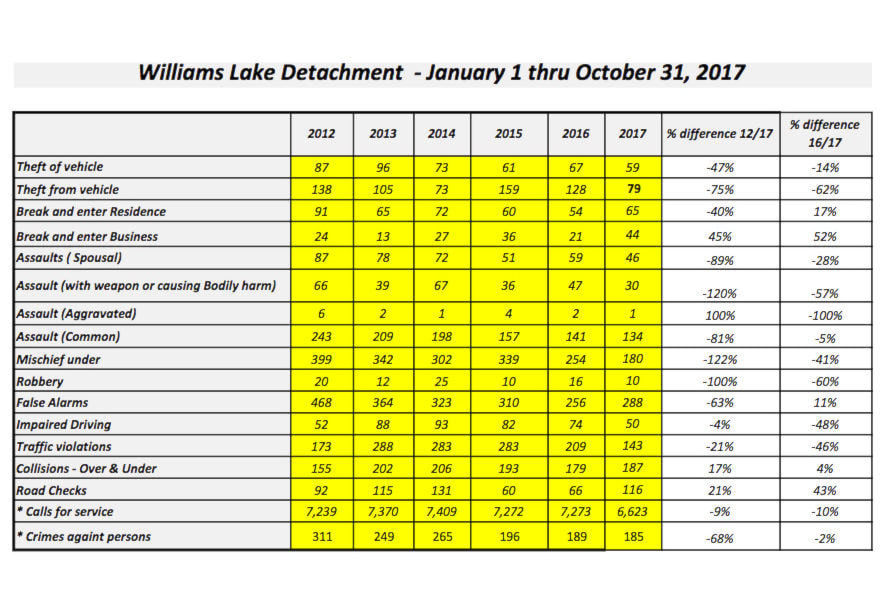Maclean’s Magazine has released its Most Dangerous Places ranking and Williams Lake is once again in the top five.
In this year’s rankings, Williams Lake emerged as the fourth most dangerous city, following North Battleford, Sask. ranked number one, Thompson, Man. and Prince Albert, Sask.
Rounding out the bottom five was Red Deer, Alta.
Insp. Jeff Pelley, Officer in Charge of the Williams Lake RCMP, said the area does have some violent crime due to a core group of offenders.
“We are actively targeting those offenders,” Pelley told the Tribune. “In my experience it is demonstrated that a small number of criminals are responsible for the majority of crimes in our community and by identifying these offenders police are able to adjust resources and strategies to arrest these individuals.”
Pelley, however, said he anticipates that 2017’s crime rates will be lower than 2016’s.
“We have additional resources and an additional crime reduction unit that has been in place since May 2017 that will certainly affect our focus on these individuals.”
When queried about the recent armed robberies at CIBC on Nov. 17 and 7-Eleven on Nov. 8 of this year, Pelley said investigations are ongoing.
“We have had several tips and information that’s being processed and we will actively pursue this, however, I cannot comment on them at this time.”
According to Maclean’s, Williams Lake’s crime severity index rose over the past year, as did its violent crime severity index.
While the assault rate was down, it was listed as well above the Canadian average per a population of 100,000.
The data used for the ranking comes from 2016, and is drawn from information released every July by Statistics Canada.
For Williams Lake, 2016 saw zero homicides, according to the data, 144 cases of assault, 25 sexual assaults and one firearm offence.
Thefts and property crime were down, although both were still recorded above Canadian averages.
Williams Lake saw 24 robberies, 79 breaking and entering incidences and 46 cases of fraud in 2016, according to Maclean’s.
While impaired driving rates went down in the lakecity, cases of cannabis, cocaine and other drug trafficking or productions went up.
In terms of rates per 100,000, Williams Lake was listed as third highest for rates of sexual assault and robbery, fifth for cocaine trafficking and eighth for assault rates.
“I know we had a number of individuals and offenders charged last year on a project targeting drug trafficking,” Pelley said. “That could be indicative of one trend where you may have additional reports or additional community members reporting crimes. We have to look at those statistics in relation to that and really dive into why the increases are occurring or why the decreases are occurring.”
Through his quarterly police commission report for city council’s Nov. 28 committee of the whole meeting, Pelley outlined statistics covering the Jan. 1 to Oct. 31 period of 2017, and compared them to the same time period in 2016.
During that time the detachment received 6,623 calls for service within the municipality and 9,138 for the whole region served by the RCMP.
Theft of vehicles have decreased 14 percent, with 59 offences in 2017 and 67 offences in 2016.
Theft from vehicles have decreased 62 per cent, with 79 offences in 2017 and 128 offences in 2016.
Break and enter to residences have increased 17 per cent, with 65 offences in 2017, up from 54 offences in 2016.
Break and enter to businesses have increased 52 per cent, with 44 offences in 2017 and 21 offences in 2016.
“There has been a 48 per cent decrease since the identified trend from Jan. 1 to March 31, 2017 that resulted in targeting a priority offender involved in these offences,” Pelley said.
Spousal assaults have decreased 28 per cent, with 46 offences in 2017 and 59 offences in 2016.
Assault offences have decreased five per cent, with 134 offences in 2017 and 141 offences in 2016.
Incidents of assault causing bodily harm/assault, with a weapon have decreased 57 per cent, with 30 offences in 2017 and 47 offences in 2016.
Aggravated assaults have decreased 100 per cent, with one offence in 2017 and two offences in 2016.
Robberies have decreased 60 per cent with 10 offences in 2017 compared to 16 offences in 2016.
Mischief under $5,000 have decreased 41 per cent, with 180 offences in 2017 and 254 offences in 2016.
False Alarms have increased 11 per cent with 288 calls for service in 2017 and 256 calls for service in 2016.
